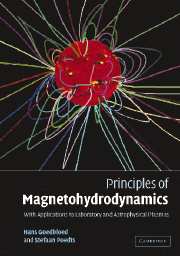3 - ‘Derivation’ of the macroscopic equations
Published online by Cambridge University Press: 22 February 2010
Summary
Two approaches
There are basically two ways of introducing the equations of magnetohydrodynamics:
(a) pose them as reasonable postulates for a hypothetical medium called ‘plasma’;
(b) derive them by appropriate averaging of kinetic equations.
Our approach, starting with Chapter 4, is mainly along the lines of the first method, pioneered by Grad [98, 32] in a series of lecture notes, using physical arguments and mathematical criteria to justify the results. In this chapter, the main steps of the second method will be discussed and shown to be somewhat unsatisfactory since they involve a number of approximations that are often difficult to justify. The reason for going through this analysis anyway is that it provides understanding of the domain of validity of the MHD description and that it indicates what kind of modifications are in order when this description fails.
Mathematically inclined readers may skip this digression, where most results from kinetic theory are not derived but simply stated, and continue reading with Chapter 4. Also, the serious student of magnetohydrodynamics is advised to turn to a detailed study of the present chapter only after a first reading of Chapters 4–11 on basic MHD since the level of this chapter is essentially that of the advanced theory, but it has been placed here because this is where it logically belongs.
We give a ‘derivation’ of the MHD equations by averaging the kinetic equations for plasmas.
- Type
- Chapter
- Information
- Principles of MagnetohydrodynamicsWith Applications to Laboratory and Astrophysical Plasmas, pp. 83 - 128Publisher: Cambridge University PressPrint publication year: 2004



